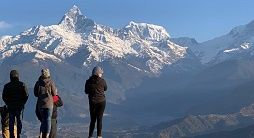- Home
- About us
- Nepal
- Tibet
- Bhutan
- Nepal Tour Packages
- Kathmandu Tour
- Nepal Tour 5 day
- Chitwan Pokhara Tour 8 day
- All Nepal Tour 12 day
- Nepal Driving Tour 12 day
- Family Tour in Nepal
- Nepal Tour Special 14 day
- Heritage Tour 14 day
- Art & Craft Tour
- Birding Tour in Nepal
- Lumbini Tour
- Honeymoon in Nepal
- Mustang Jeep Tour
- Tiji Festival Tour
- Wildlife safari Tour
- Hindu pilgrimage tour
- Buddhist Pilgrimage Tour
- Yoga Meditation Tour
- Volunteer Nepal
- Nepal Treks
- Tibet Tour Package
- Bhutan Tour Package
- Travel Tips
- Gallery
- Contact
- Blog
- XML
- Kathmandu Tour 2 - 5 Day
- Nepal Tour 6 Day
- Glimpse of Nepal 8 Day
- All Nepal Tour 12 Days
- Nepal Driving Tour
- Family holiday in Nepal
- Nepal Tour Special 14 Days
- Nepal Heritage Tour 14 Days
- Nepal Walking holiday 11 Days
- Art and Craft Tour
- Nepal Bird watching Tour
- Lumbini Tour
- Buddhist Pilgrimage Tour
- Tiji Festival Tour
- Pikey Peak Trek New Route
- Mardi Himal Trek New Route
- Khopra Ridge Trek New Route
- Pun Hill Trek
- Everest Trek
- Gosaikunda Trek 8 days
- Lower Mustang Trek
- Langtang Trek
- Kathmandu valley trek 3-4 days
- Short ABC Trek6 - 8 days
- Langtang Heli Trek 4 days
- Kailash Tour Tibet
- Tibet Overland Tour
- Lhasa Tour 4 day
- Nepal Tibet Tour 14 day
- See Bhutan Tour 4 day
- Bhutan walking Tour
- Thimphu Festival Tour
- Nepal Bhutan Tour 14 Days

Best short treks from Pokhara
for Spring 2024
5 most popular tour of Nepal
- iTourNepal.comTravelling with kids
Tibet is now Open
Nepal art, craft & architecture tour

Get the deeper insight of Tantric, Buddhist and Vedic cultural life, visit local artisans to watch them crafting metal and wooden handicrafts. Learn and see Ayurveda and Vedic Astrology in practice.
Transport : Private car & Flight
Most of the writers, after being familiar with Nepalese society, gave common views as in the dictum “Every other building in the valley is a temple and every other day is a festival.” What appeared to them as a festival is the native people’s day to day activities and artistically bedecked medieval edifices embedded with various pantheons. Infact ethnic groups were stratified into various occupational groups, which lead to specialization in the task particular group or caste was following. However, Nepal being closed until 1950, the art was never industrialized and was very less influenced by modern techniques.
This special package guides you through the ancient ways of life, medicinal practices (Ayurveda), art and architecture (Vastushastra), Vedic astrology and more.
INCLUDES :
- All accommodation with breakfast and taxes included.
- All ground transportation by private vehicle
- Guided sightseeing as per the theme.
- All entrance fees included.
- 2 N 3 D Chitwan jungle saferi package based on Tharu community homestay. All meals and safari activities are included.
- Easy 1 N 2 D hike to ex-Gurkha village and meet with shaman on request. Comfortable lodge with all meals included.
EXCLUDES :
- Delay and cancellation because of naturl phenomenon.
- Any type of insurances. Rescue and evacuation will be done on your account.
- Bottled drinks and beverages.
- Tea breaks, snacks or anything purchased directly beside the meals included.
Art and Craft Tour Itinerary
Day 01: Arrive to Kathmandu / Transfer to Hotel / Familiarization walk
Day 02: Tour of Tibetan Buddhism in Kathmandu
Day to observe Tibetan Buddhism in Nepal, Tibetan Refugees and skilledoccupation they have been pursuing. The art of Thanka painting, carpet weavingand sculpting various Buddhist curios mark the particular area of Kathmandu asa “Little Tibet ''. The area renowned as Boudha has more than 45 monasteries withinits small premises. We will also visit a couple of monasteries to observemonastic life.
Day 03: Blending of Hinduism and Buddhism
Today’s tour will be focused on religious tolerance or amalgamation of Hinduism and Buddhism in the Kathmandu Valley. The two streams developed in prehistoric time had Kathmandu as a confluence in the medieval age, which is specially depicted in the struts, tympanums and entrances flanked by guardian deities. Our expert will separate each figure’s root in Hinduism and Buddhism, the legend and historical behind them and their integrations.
Day 04: Vastu Shastra – tour of medieval architecture
On the day we will shed light on ancient architecture of Stupas, temples and town planning. The ancient architecture was so well developed that they were resistant to natural catastrophes. Pulsing through the streets of Kathmandu you can’t imagine once these cities were planned based on the ancient knowledge of 'Vastu Shastra' (the material science). Vastu Shastra is a knowledge of human's well being, which can only be achieved when we are in harmony with nature and universal flow of energy.
Day 5-6 : Into the Tharu home in the land of Tiger
The best way to learn about the day to day life of local Tharu is by staying with them. We will stay in a comfortable community homestay and spend time with local families learning their way of life and their survival skills in the jungle roved by the Royal Bengal Tigers. The accommodation will be in traditional Tharu houses built of mud, 'Khariya' grass, timbers and tiles. These charming nature-friendly houses are fast disappearing with the shortage of raw materials and increased cost of labourers. The Tharu women transform the outer walls and verandahs of their homes into colorful paintings said to be dedicated to Lakshmi, the Hindu goddess of prosperity and fertility. They grow barley, wheat, maize, and rice, as well as raise animals such as chickens, sheeps, ducks, pigs, and goats. In the big rivers, they use large nets to fish.
Visit the Chitwan national park with a local Tharu guide to see some of the endangered animals and birds including the most elusive Royal Bengal Tiger.

Day 7-9 : The Gurkhas and Shamans from the mountains
Shamanism is still practiced in the mountain of Nepal. They worked as faith healers connecting with the sprits for thousands of years. The mountains of Nepal is also the land of brave Gurkha solders who still keep the legends serving British and Indian army.
Drive past Pokhara and stay in the Gurkha soldier's village. Meet the shamans and learn the simple village life. They don't have much of the sophisticated art but their lifestyle so close to the nature is inspiring life skill to learn.

Day 10: The metal sculptors of Patan
Objective of the day would be studying metal sculpting. The unique feature of more than 150 medieval monasteries of Patan is its well bedecked metal statues, stupas, entrance gates and pagodas. Lalitpur meaning ‘the city of fine art’ still induces visitors about the suitability of its name as the significant numbers of people still pursue the age-old occupation. We will also observe the traditional art of the lost wax process of metal sculpting.

Day 11: Self-sufficient medieval world of Bhaktapur
Bhaktapur-the city of devotees is also known as a living museum for the town remained firm to modernization and populace still practice the age old traditions with same enthusiasm. Populace was stratified into occupational groups for the efficiency in art and craft skills. Some of which are still observed such as potter’s spinning out clay utensils, handmade paper productions and wood carving.
Day 12: Depart kathmandu
Lwang village community homestay
Art & Craft Tour with us:
- Support local company.
- Expertise over 20 years.
- Cost effective Treks.
- Cultural immersion experience.
- High quality services.
- Eco friendly & sustainable practices.
Bhutan Tour 4 day
Take the breathtaking flight along the sprawling Himalayan peaks to Bhutan from Kathmandu. Enjoy the splendor of Himalayan Shangri La.Buddhist pilgrimage of Nepal
8 nights 9 days
Visit the meditation caves of Tilopa, Naropa, Nagarjuna and Padmasambhava. Lumbini and its surrounding have evidences of life story of Lord Buddha.
 Heritage Tour 14 Days
Heritage Tour 14 Days
Sagarmatha (Everest) National Park, medieval monuments of Kathmandu, Chitwan National Park and Lumbini - the birth place of Buddha in Nepal are listed by UNESCO as World Heritage sites.
Optional Activities

Everest sightseeing Flight
The 1 hr. fixed wing Himalayan sightseeing flight is the best way to see Mt Everest and other peaks east of Kathmandu.- Window Seat
- Everest View
- Airport

Lhasa Tour - Tibet
Combine this tour with 3 nights 4 days Lhasa Tour starting and ending in Kathmandu, Nepal.Yoga and wellness Tour
If you have extra days in Kathmandu or Pokahra, try one of our highly recommended yoga and wellness tourHiking around Kathmandu

Kathmandu being surrounded by foothills of Himalaya provide beautiful hike and short trek.
© iTourNepal.com Pvt. Ltd. 2024
Nasanh Dyah Marg, Thamel, Kathmandu, 44600, Nepal
977 9826166085
: 977 1 4363643 , 4412011
:




